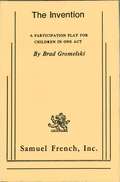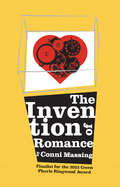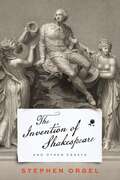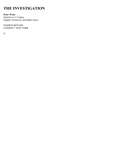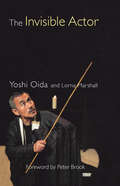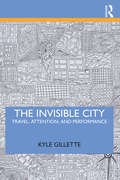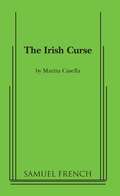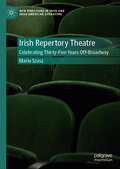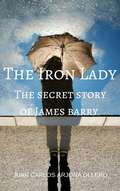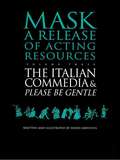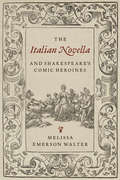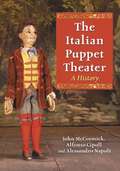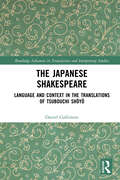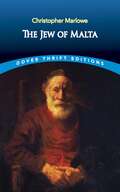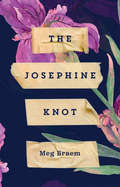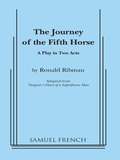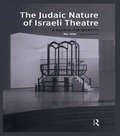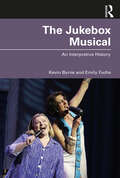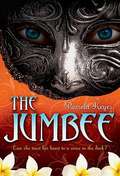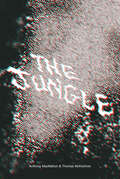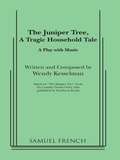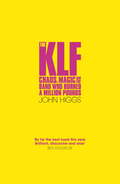- Table View
- List View
The Invention
by Brad Gromelski6 Characters with Audience Participation / The play involves the efforts of the Narrator and three Fun Merchants to assemble a toy machine they have invented. Conflict arises when Kalibad, a toy spy, arrives and attempts to sabotage the invention. The main character in the show is The Audience, whose vocal and physical participation is necessary for the play to exist. The children of the audience shout warnings of Kalibad's arrival, carry and actually assemble the invention on stage, put together a cage and trap Kalibad inside of it, and co operate in other tasks. If the children are successful in their efforts, they receive a surprise souvenir of their adventure. Playing time is forty five minutes to one hour, depending upon the amount of participation desired. No stage is necessary.
The Invention of Romance
by Conni MassingThirtysomething Kate has devoted much of her adult life to her career as a museum curator. She’s just been tasked with mounting an exhibit about the history of romance and love despite her own string of romantically unsuccessful relationships. Intent on better curating the show, Kate investigates love in books and on hilariously disastrous dates. As her love life enters a comical death spiral, her long-widowed mother rekindles an old romance with a man she co-starred with in a play sixty years ago. Finding the partial script of her mother’s play, yellow with age and dog-eared, Kate sets out to complete its missing ending.
The Invention of Shakespeare, and Other Essays
by Stephen OrgelIn his own time, Shakespeare was not a monument, but a man of the theater whose plays were less finished artifacts than works in process. In contrast to a book, a thing we have come to think of as final and achieved, a play is a work for performance, with each performance based only in part on a text we call a script. That script may well have had imperfections that the actors may or may not have noticed as they turned it into a performance. There were multiple versions of the scripts and never a "final" one. Every revival of a play—indeed, every subsequent performance—was and always will be different. Nevertheless, when we study Shakespeare, we are likely to come to him via printed texts that are scripts masquerading as books, and the impulse is to turn them into finished artifacts worthy of their author's dignity.In The Invention of Shakespeare, and Other Essays Stephen Orgel brings together twelve essays that consider the complex nature of Shakespearean texts, which often include errors or confusions, and the editorial and interpretive strategies for dealing with them in commentary or performance. "There is always some underlying claim that we are getting back to 'what Shakespeare actually wrote,'" Orgel writes, "but obviously that is not true: we clarify, we modernize, we undo muddles, we correct or explain (or explain away) errors, all in the interests of getting a clear, readable, unproblematic text. In short, we produce the text that we want him to, or think he must have written. But one thing we really do know about Shakespeare's original text is that it was hard to read."
The Investigation: Oratorio in 11 Cantos
by Peter WeissHubert Selby Jr. began as a writer of short stories and he excels at this form. He offers a passionate empathy with ordinary dreams, a brilliant ear for the street and for the voices of conscience and self-deceit that torment us all.
The Invisible Actor
by Lorna Marshall Yoshi OidaFirst Published in 1998. Routledge is an imprint of Taylor & Francis, an informa company.
The Invisible City: Travel, Attention, and Performance
by Kyle GilletteThe Invisible City explores urban spaces from the perspective of a traveller, writer, and creator of theatre to illuminate how cities offer travellers and residents theatrical visions while also remaining mostly invisible, beyond the limits of attention. The book explores the city as both stage and content in three parts. Firstly, it follows in pattern Italo Calvino's novel Invisible Cities, wherein Marco Polo describes cities to the Mongol emperor Kublai Khan, to produce a constellation of vignettes recalling individual cities through travel writing and engagement with artworks. Secondly, Gillette traces the Teatro Potlach group and its ongoing immersive, site-specific performance project Invisible Cities, which has staged performances in dozens of cities across Europe and the Americas. The final part of the book offers useful exercises for artists and travellers interested in researching their own invisible cities. Written for practitioners, travellers, students, and thinkers interested in the city as site and source of performance, The Invisible City mixes travelogue with criticism and cleverly combines philosophical meditations with theatrical pedagogy.
The Irish Curse
by Martin CasellaComedy5mWhat "The Irish Curse" is - and how it manifests itself - is the raw centerpiece of this wicked, rollicking and very funny new play. From its blistering language to its brutally honest look at sex and body image, The Irish Curse is a revealing portrait of how men, and society, define masculinity. In doing so, it dares to pose the fundamental question that has been on the minds of men since the beginning of time: "Do I measure up to the next guy?" Size matters to a small group of Irish-American men (all professionally successful New Yorkers) who meet every Wednesday night, in a Catholic church basement, at a self-help group for men with small penises. This alleged Irish trait is the focus of their weekly sessions, as they all feel this "shortcoming" has ruined their lives. One evening, when a twenty-something blue-collar guy joins the group, he challenges everything the other men think about "the Irish Curse" ...tackling their obsession with body image and unmasking the comical and truthful questions of identity, masculinity, sex and relationships that men must face every day in the world."Casella is at his best when he's going for laughs. He gets a lot of them." -The New York Times "Critics Pick! Colorful character-driven comedy." -Time Out New York "The Irish Curse is a very human and even humane play. You will find yourself rooting for these esteem-building sessions to succeed." -Michael Kuchwara, Associated Press "ONE OF THE BEST PLAYS OF THE YEAR! Truly original, truly hysterical and truly touching! You will be enthralled! -Talk Entertainment
The Irish Repertory Theatre: Celebrating Thirty-Five Years Off-Broadway (New Directions in Irish and Irish American Literature)
by Maria SzaszThe Irish Repertory Theatre: Celebrating Thirty-Five Years Off-Broadway is the first book-length history of the multi-award winning Off-Broadway Irish Repertory Theatre Company, from its beginning in 1988 to its thirty-fifth season in 2023. The book considers how the Irish Rep’s plays and musicals reflect the Irish diaspora, the relationship between Ireland and America, and what it means to be Irish and Irish American, both historically, and in the twenty-first century, including how the Irish Rep is showcasing more diverse voices and experiences, from women, the LGBTQIA+ community, and Irish and Irish American people of color.
The Iron Lady (The secret story of James barry)
by Juan Carlos Arjona Ollero Claudia Elena ArredondoThis historical novel talks about Margaret Ann Bulkley, most famously known as James Barry, a doctor who served the British flag and for it sacrificed herself to become a man and be able to follow her dreams in pursuit of an education which was in fact forbidden to her gender.
The Italian Commedia and Please be Gentle
by David GriffithsFocusing on Commedia Dell'Arte, this work provides a historical and critical commentary of the Commedia. It highlights common factors between this genre and that of the Japanese Noh theatre. The author proposes six similarities: characters familiar to their audience and masked, minimal properties and scenery with the focus on the actor, the "families" of performers, a sharp mind as well as an agile body, a professional living on these skills and patronage, and a knowledgeable audience. Complementing this book is the play "Please Be Gentle" which explores the various tricks and devices of Commedia Dell'Arte acting.
The Italian Novella and Shakespeare’s Comic Heroines
by Melissa WalterUsing a comparative, feminist approach informed by English and Italian literary and theatre studies, this book investigates connections between Shakespearean comedy and the Italian novella tradition. Shakespeare’s comedies adapted the styles of wit, character types, motifs, plots, and other narrative elements of the novella tradition for the Elizabethan and Jacobean stage, and they investigated social norms and roles through a conversation carried out in narrative and drama. Arguing that Shakespeare’s comedies register the playwright’s reading of the novella tradition within the collaborative playmaking context of the early modern theatre, this book demonstrates how the comic vision of these plays increasingly valued women’s authority and consent in the comic conclusion. The representation of female characters in novella collections is complex and paradoxical, as the stories portray women not only in the roles of witty plotters and storytellers but also through a multifaceted poetics of enclosed spaces – including trunks, chests, caskets, graves, cups, and beds. The relatively open-ended rhetorical situation of early modern English theatre and the dialogic form and narrative material available in the novella tradition combine to help create the complex female characters in Shakespeare’s plays and a new form of English comedy.
The Italian Puppet Theater: A History
by John Mccormick Alessandro Napoli Alfonso CipollaThis is the first full-length, English language study of Italian puppetry. Chapters describe Italy's rich puppet theater tradition through the end of the eighteenth century; the golden age of glove puppets, marionettes and pupi; commedia dell'arte and the puppet stage; the evolution of repertoires; music and spectacle; and changes during the twentieth century. Concluding chapters offer in-depth studies of two marionette companies, Turin's Lupi and Catania's Fratelli Napoli.
The Japanese Shakespeare: Language and Context in the Translations of Tsubouchi Shōyō (ISSN)
by Daniel GallimoreOffering the first book-length study in English on Tsubouchi and Shakespeare, Gallimore offers an overview of the theory and practice of Tsubouchi’s Shakespeare translation and argues for Tsubouchi’s place as "the Japanese Shakespeare." Shakespeare translation is one of the achievements of modern Japanese culture, and no one is more associated with that achievement than the writer and scholar Tsubouchi Shōyō (1859–1935). This book looks at how Tsubouchi received Shakespeare in the context of his native literature and his strategies for bridging the gaps between Shakespeare’s rhetoric and his developing language. Offering a significant contribution to the field of global Shakespeare and literary translation, Gallimore explores dominant stylistic features of the early twentieth-century Shakespeare translations of Tsubouchi and analyses the translations within larger linguistic, historical, and cultural traditions in local Japanese, universal Chinese, and spiritual Western elements. This book will appeal to any student, researcher, or scholar of literary translation, particularly those interested in the complexities of Shakespeare in translation and Japanese language, culture, and society.
The Jew of Malta: With Related Texts (Dover Thrift Editions)
by Christopher MarloweThe spirit of Machiavelli presides over The Jew of Malta, in which the title character relentlessly plots to maintain and extend his political influence and wealth. A paragon of remorseless evil, Barabas befriends and betrays the Turkish invaders and native Maltese alike, incites a duel between the suitors for his daughter's hand, and takes lethal revenge upon a convent of nuns.Both tragedy and farce, this masterpiece of Elizabethan theater reflects the social and political complexities of its age. Christopher Marlowe's dramatic hybrid resonates with racial tension, religious conflict, and political intrigue -- all of which abounded in 16th-century England. The playwright, who infused each one of his plays with cynical humor and a dark world view, draws upon stereotypes of Muslim and Christian as well as Jewish characters to cast an ironic perspective on all religious beliefs.The immediate success of The Jew of Malta on the Elizabethan stage is presumed to have influenced Marlowe's colleague, William Shakespeare, to draw upon the same source material for The Merchant of Venice. The character of Barabas is the prototype for the well-known Shylock, and this drama of his villainy remains a satirical gem in its own right.
The Josephine Knot
by Amiel Gladstone Meg BraemAfter Samantha’s baba dies, her fractured family is summoned to pick through the house full of belongings and trash, leaving taped notes on whatever they want to take. Between old napkins, a closet full of ketchup packets, and a freezer full of rotting meat are gems like a grandfather clock and plastic deer statuettes that hold more sentiment. While her father David sifts through his own memories, all Samantha wants is to find a simple object that could represent her place in the family. When other family members arrive, tug of wars and passive-aggressive conversations commence. In a house full of junk and sadness, it comes down to Samantha and David to find a new way to fit together.
The Journey of Fifth Horse
by Ronald RibmanA reader in a publishing house is given a diary to take home and read overnight. This sets three worlds spinning: the reader's dream world, the real world and the world of the diarist. In his dreams the reader is to marry the owner's daughter while his lady is eager to wed and bed him. In reality, he proposes to the landlady and is promptly scorned. The diarist loved a girl who fell victim to a dashing cossack and was left pregnant when his regiment moved on. The diarist is scorned for having provoked a duel, and the girl will not even have him as a foster father for the child.
The Judaic Nature of Israeli Theatre: A Search for Identity (Contemporary Theatre Studies #Vol. 31.)
by Dan UrianTheatre has, since the time of the Jewish Enlightenment, served the secular community in its conflict with the religious. This book surveys the secular-religious rift and then describes the enhanced concern of the secular community in Israel for its own Jewishness and its expression in the theatre - especially following the 1967 War. It then moves on to a specific study of the play Bruira and finally reviews the phenomenon of the return to Orthodox Judaism by secular individuals.
The Jukebox Musical: An Interpretive History
by Kevin Byrne Emily FuchsThis is a comprehensive guide to the unique genre of the jukebox musical, delving into its history to explain why these musicals have quickly become beloved for multiple generations of theatergoers and practitioners. Providing a concise exploration of the three main categories of the jukebox musical—biographical, genre-specific, and artist catalog—this text is perfect for those wishing to learn more about this relatively recent and unique genre of theater. It identifies the dramaturgical needs that arise in these productions and explains how certain works become critical darlings or fan favorites. How much information needs to be conveyed through song and how much can be left up to interpretation by the audience? What kinds of changes occur when a repertoire of songs is reimagined for the stage? In addition to these insightful explorations, it also reveals how creative teams tackle the unique challenge of weaving together plot and song in order to convey meaning, emotion, excitement, and beauty in these increasingly popular forms of theater. The Jukebox Musical: An Interpretive History is written for students, performers, and musical theater enthusiasts alike: this is the ideal introduction to one of the twnty-first century's most popular and successful stage genres.
The Jumbee
by Pamela KeyesWhen Esti Legard starts theater school on Cariba, she's determined to step out of the shadow of her late father, a famous Shakespearean actor. But on an island rife with superstition, Esti can't escape the darkness. In the black of the theater, an alluring phantom voice-known only as Alan-becomes her brilliant drama tutor, while in the light of day Esti struggles to resist her magnetic attraction to Rafe, the local bad boy. Toppled sets, frightening rumors of jumbee ghosts, and brewing tropical storms culminate in a tantalizingly spooky finale where romance sizzles and truths are unmasked. Laced with eerie mystery and the lush scenery of the West Indies, this modern Phantom is perfect for readers who like their love stories served with spine-tingling suspense.
The Jungle
by Anthony MacMahon Thomas McKechnieInspired by Upton Sinclair’s novel The Jungle.This play paints a stark and realistic portrait of what it’s like to live in cities such as Toronto currently, especially as a young person battling late-stage capitalism.First produced by Tarragon Theatre, Toronto, in October 2019
The Juniper Tree, A Tragic Household Tale
by Wendy KesselmanPlay with music / 1 m., 1 f. plus small on stage combo and f. narrator/singer. / Exterior / "Wendy Kesselman has taken 'The Juniper Tree' (the Brothers Grimm story), and turned it into a haunting little musical in the shape of a ballad. . . . The events- including murder and cannibalism- are gruesome, but the telling has a childlike Story Theatre quality... as exemplified by her ballad of The Juniper Tree and her earlier play My Sister in This House, the versatile Miss Kesselman has a fabulist's view of guilt and retribution." N.Y. Times.
The KLF: Chaos, Magic and the Band who Burned a Million Pounds
by John Higgs'By far the best book this year, brilliant, discursive and wise' BEN GOLDACRE. The strange tale of the death, life and legacy of the hugely successful band.They were the bestselling singles band in the world. They had awards, credibility, commercial success and creative freedom. Then they deleted their records, erased themselves from musical history and burnt their last million pounds in a boathouse on the Isle of Jura. And they couldn't say why.This is not just the story of The KLF. It is a book about Carl Jung, Alan Moore, Robert Anton Wilson, Ken Campbell, Dada, Situationism, Discordianism, magic, chaos, punk, rave, the alchemical symbolism of Doctor Who and the special power of the number 23.Wildly unauthorised and unlike any other music biography, THE KLF is a trawl through chaos on the trail of a beautiful, accidental mythology.
The Kabuki Handbook
by Giovanna M. Halford Aubrey S. HalfordKabuki has been described as "in the main, the finest theatre art in the world," and its ever-growing popularity both in Japan and abroad bears witness to its tremendous dramatic effectiveness. The fact that many persons tend to regard it as mere spectacle, thus missing the greater part of its moving appeal, has been due to the lack of any key to the intricacies of its plots and its unfamiliar stage conventions. Here at last is a genuine key, one which opens wide vistas of understanding and appreciation. Included here are lucid synopses and crystal-clear explanations of the hundred odd plays which form the backbone of the classical Kabuki repertoire and constitute over twice that many individual program items. Equally as valuable as the synopses are the informative and entertaining Notes explaining the many points that have proved perplexing to the non-Japanese spectator. Both synopses and notes are provided with a careful system of cross references and an indispensable index, all making for ready use and saving the spectator from "dwelling so much on some minor, but incomprehensible, point that the thread of the drama is lost."
The Kabuki Handbook
by Giovanna M. Halford Aubrey S. HalfordKabuki has been described as "in the main, the finest theatre art in the world," and its ever-growing popularity both in Japan and abroad bears witness to its tremendous dramatic effectiveness. The fact that many persons tend to regard it as mere spectacle, thus missing the greater part of its moving appeal, has been due to the lack of any key to the intricacies of its plots and its unfamiliar stage conventions. Here at last is a genuine key, one which opens wide vistas of understanding and appreciation. Included here are lucid synopses and crystal-clear explanations of the hundred odd plays which form the backbone of the classical Kabuki repertoire and constitute over twice that many individual program items. Equally as valuable as the synopses are the informative and entertaining Notes explaining the many points that have proved perplexing to the non-Japanese spectator. Both synopses and notes are provided with a careful system of cross references and an indispensable index, all making for ready use and saving the spectator from "dwelling so much on some minor, but incomprehensible, point that the thread of the drama is lost."
The Kabuki Handbook
by Giovanna M. Halford Aubrey S. HalfordKabuki has been described as "in the main, the finest theatre art in the world," and its ever-growing popularity both in Japan and abroad bears witness to its tremendous dramatic effectiveness. The fact that many persons tend to regard it as mere spectacle, thus missing the greater part of its moving appeal, has been due to the lack of any key to the intricacies of its plots and its unfamiliar stage conventions. Here at last is a genuine key, one which opens wide vistas of understanding and appreciation. Included here are lucid synopses and crystal-clear explanations of the hundred odd plays which form the backbone of the classical Kabuki repertoire and constitute over twice that many individual program items. Equally as valuable as the synopses are the informative and entertaining Notes explaining the many points that have proved perplexing to the non-Japanese spectator. Both synopses and notes are provided with a careful system of cross references and an indispensable index, all making for ready use and saving the spectator from "dwelling so much on some minor, but incomprehensible, point that the thread of the drama is lost."
